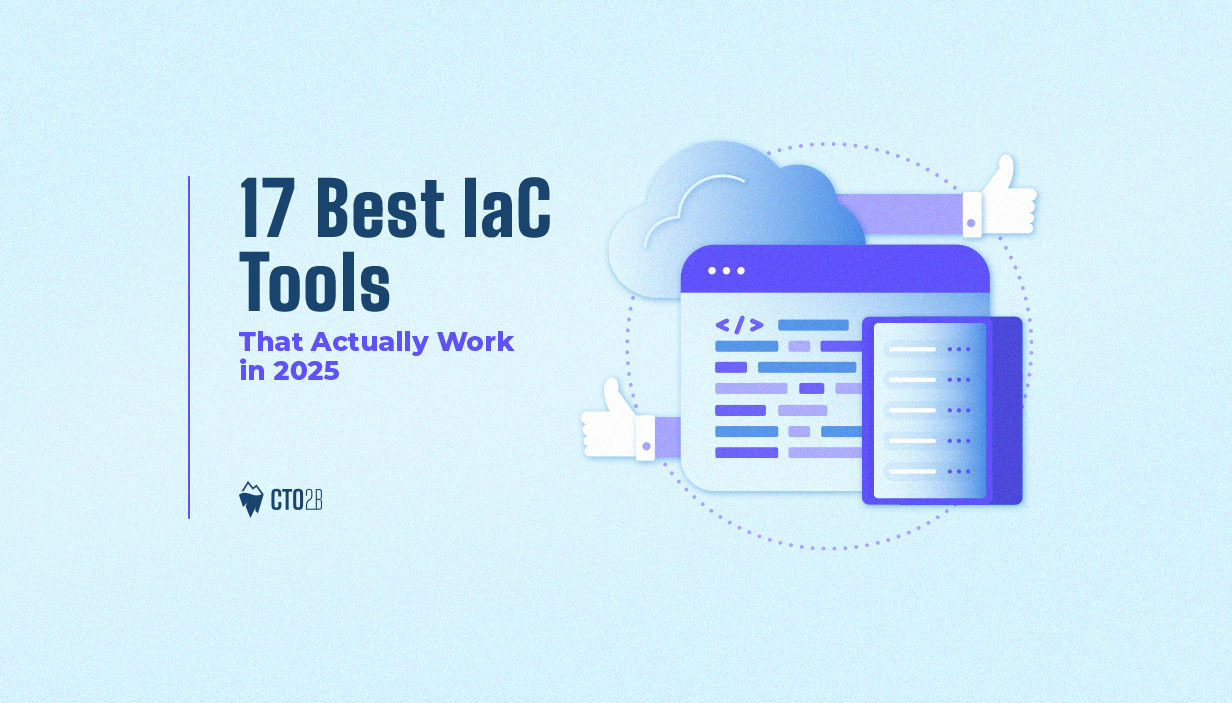Infrastructure as Code (IaC) has transformed the way teams manage infrastructure, making deployments faster, more consistent, and less error-prone. Instead of relying on manual processes, IaC lets you define infrastructure in code, bringing the benefits of automation, version control, and repeatability to operations.
Today, IaC tools are essential for achieving scalability, security, and agility in modern IT environments. From provisioning cloud resources to managing networking components, they help teams reduce manual intervention, enforce compliance, and ensure consistent environments across development, testing, and production.
In this guide, we explore the 17 best Infrastructure as Code tools that simplify automation and optimize infrastructure management.
17 Best IaC Tools
1. CTO2B
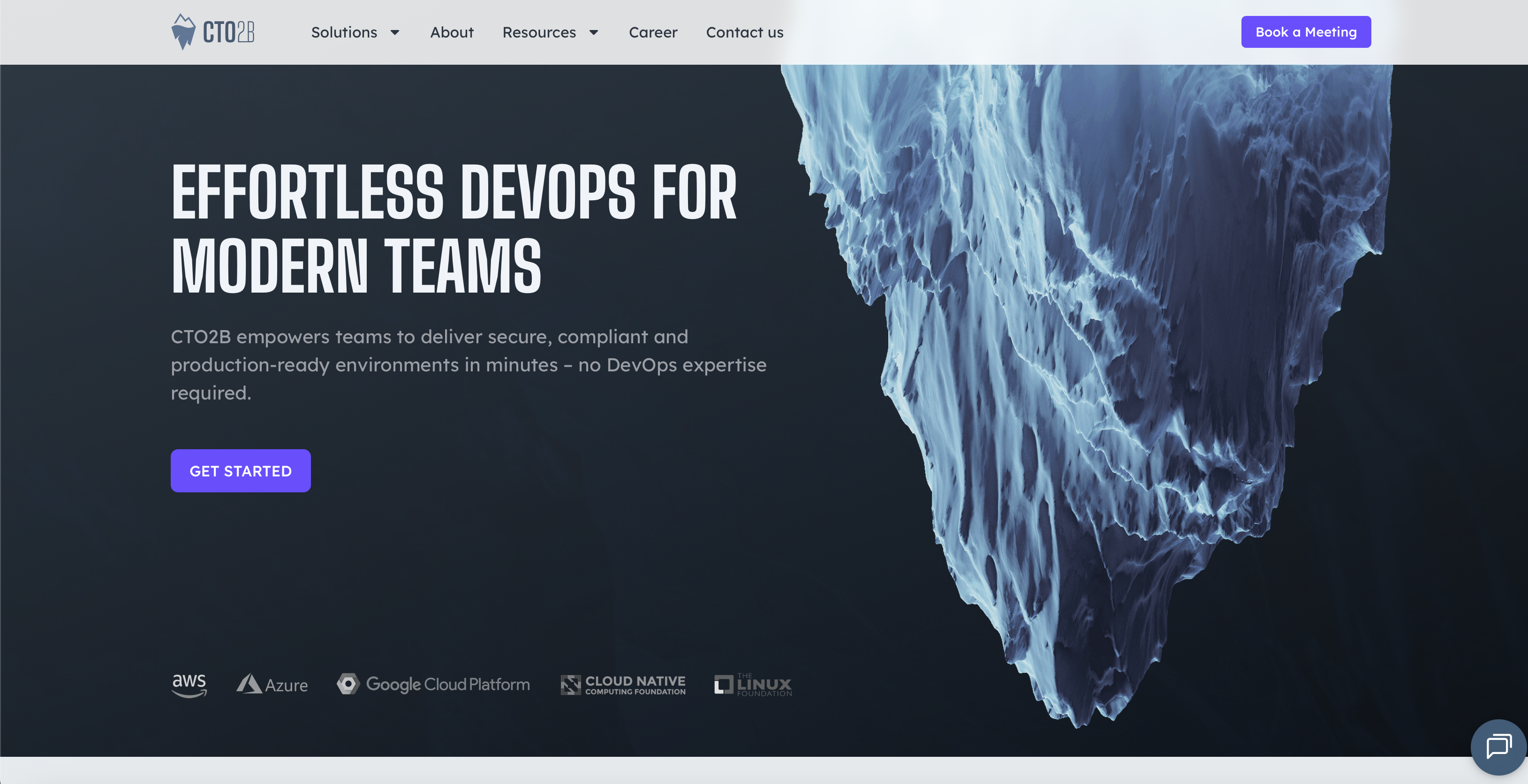
CTO2B empowers teams to deliver secure, compliant and production-ready environments in minutes, no DevOps expertise required. This automation platform handles infrastructure deployment while maintaining exceptional security standards across multi-cloud environments.
CTO2B Key Features
CTO2B excels through automated infrastructure capabilities that eliminate hours of manual configuration work. The platform provides centralized multi-cluster management across AWS, GCP, Azure, and Kubernetes environments. Core capabilities include:
- Infrastructure as Code with GitOps integration for version control and consistency
- Real-time monitoring and automated scaling for optimal performance
- Integrated CI/CD tools with customizable automation workflows
- Disaster recovery with cross-region redundancy and instant failover mechanisms
- Pod-based identity management for fine-grained access control
CTO2B Pros and Cons
Pros:
- Saves up to 40% on cloud infrastructure costs through smart resource allocation
- Reduces development time by at least 30%
- Increases cloud infrastructure security by up to 60%
- Unified platform eliminating the need for multiple tools
- User-friendly interface accessible to non-DevOps teams
Cons:
- Enterprise focus may exceed small team requirements
- Requires initial setup and onboarding period
CTO2B Best Use Cases
CTO2B delivers exceptional value for:
- SaaS businesses operating software in the cloud
- E-commerce platforms handling high traffic volumes
- Financial institutions requiring stringent security standards (as demonstrated with Inventi)
- Companies implementing multi-cloud strategies
- Organizations transitioning between cloud environments
CTO2B stands as the premier choice among infrastructure as code tools in 2025, combining unmatched automation capabilities with hands-on expertise that delivers measurable results.
2. Terraform
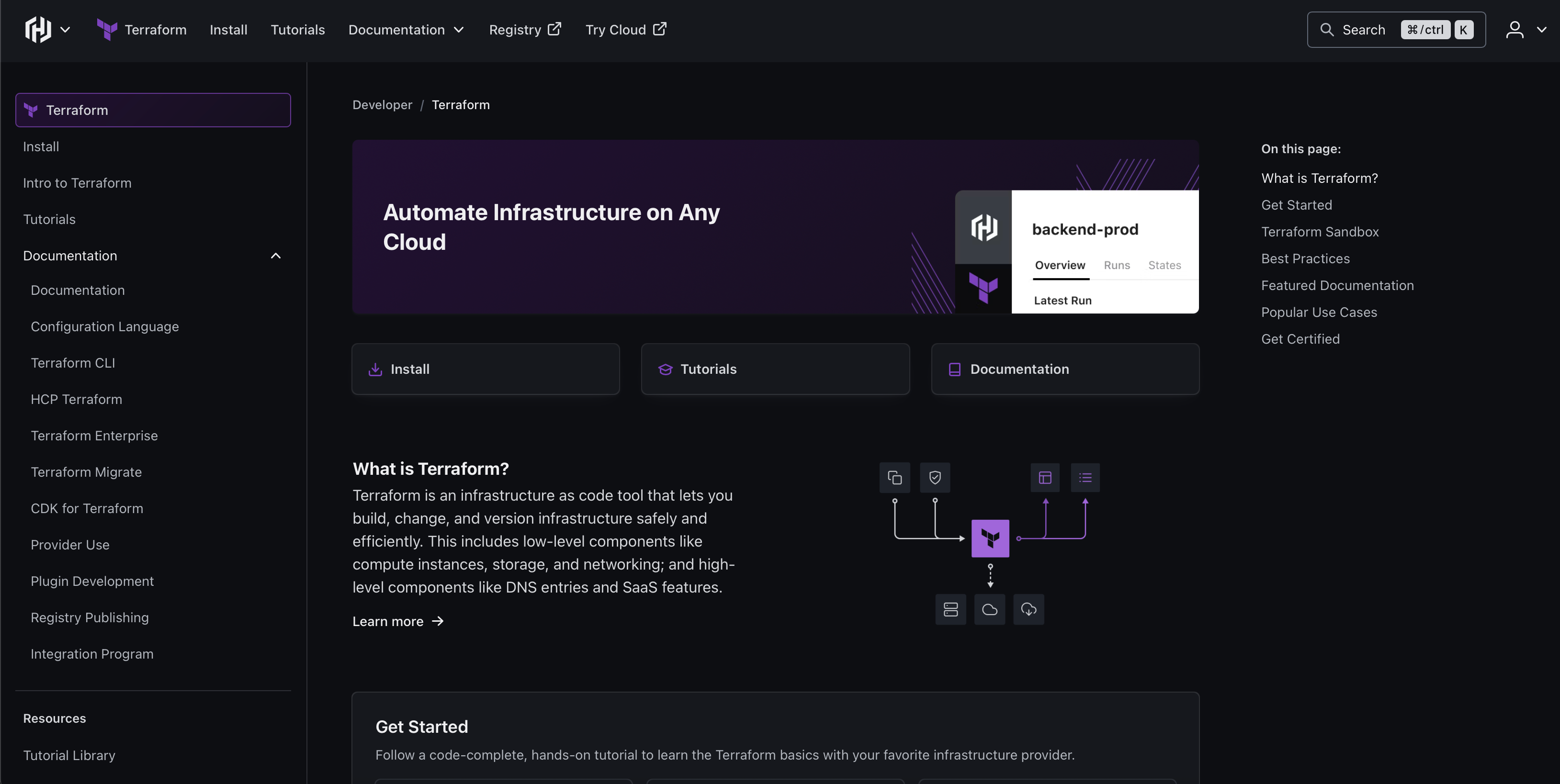
HashiCorp’s Terraform ranks among the most widely-adopted infrastructure as code solutions according to the State of IaC 2023 report. This open-source platform enables organizations to define, provision, and manage infrastructure through human-readable configuration files rather than manual processes.
Terraform Key Features
Terraform operates through a declarative approach where you specify the desired end-state of your infrastructure. Core capabilities include:
- Multi-cloud support with over 1,000 providers for AWS, Azure, GCP, and others
- Human-readable configuration language (HCL) that simplifies infrastructure code creation
- State tracking that monitors resource changes throughout deployments
- Automatic calculation of dependencies between resources
- Version control integration for safe infrastructure collaboration
Terraform Pros and Cons
Pros:
- Consistent deployment across multiple cloud platforms
- Reusable modules for standardizing infrastructure components
- Large active community with over 18,600 Terraform-tagged questions on Stack Overflow
- Idempotent operations that prevent unnecessary redeployments
Cons:
- Steep learning curve, especially for those unfamiliar with IaC concepts
- State file management complexities that require careful handling
- Dependency on third-party plugins for certain provider integrations
Terraform Best Use Cases
Terraform excels in managing complex multi-cloud infrastructures where organizations need unified workflows across different providers. The platform proves highly effective for multi-tier application deployments, allowing teams to manage infrastructure components independently while handling dependencies between tiers. Terraform delivers significant value for global applications requiring deployment across multiple regions to ensure low latency and high availability.
For organizations building self-service infrastructure models, Terraform enables centralized operations teams to create standardized modules that product teams can use independently.
3. Pulumi
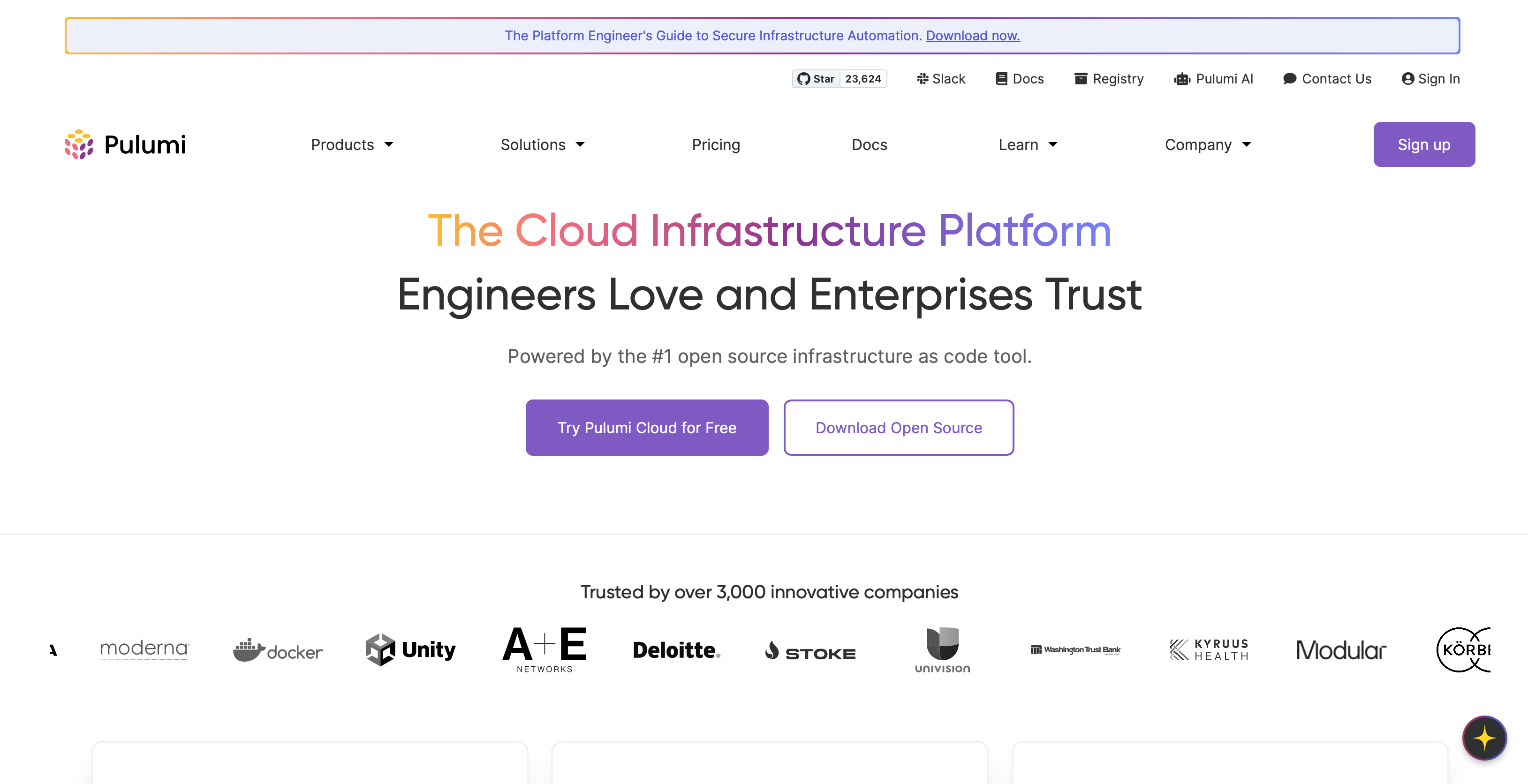
Pulumi breaks from traditional IaC approaches by empowering engineers to use familiar programming languages for infrastructure management. This open-source platform supports TypeScript, JavaScript, Python, Go, .NET, Java, and markup languages like YAML.
Pulumi Key Features
Multi-language support enables developers to apply existing programming expertise to infrastructure challenges. Core capabilities include:
- Complete API coverage for AWS, Azure, Google Cloud, and Kubernetes with same-day updates
- Rich abstraction capabilities through reusable components and packages
- Testing frameworks for unit, property, and integration testing
- Dynamic providers that extend support to platforms without existing providers
Pulumi Pros and Cons
Pros:
- Familiar programming languages eliminate new syntax learning requirements
- Powerful abstractions through loops, conditions, and functions
- Automatic secret encryption in transit and at rest
- Organizations using Automation API manage 10x more infrastructure per engineer
Cons:
- Non-coding teams face steeper adoption curves
- Directory structure complexity grows with project scale
- Implementation requires more detailed documentation
Pulumi Best Use Cases
Complex infrastructure with dynamic requirements represents Pulumi’s sweet spot. Teams benefit most when managing cloud complexity, adopting modern architectures, or increasing collaboration between infrastructure, development, and security teams. Success stories include Tableau, Snowflake, and Mercedes-Benz Research & Development, who substantially improved development workflows.
4. AWS CloudFormation
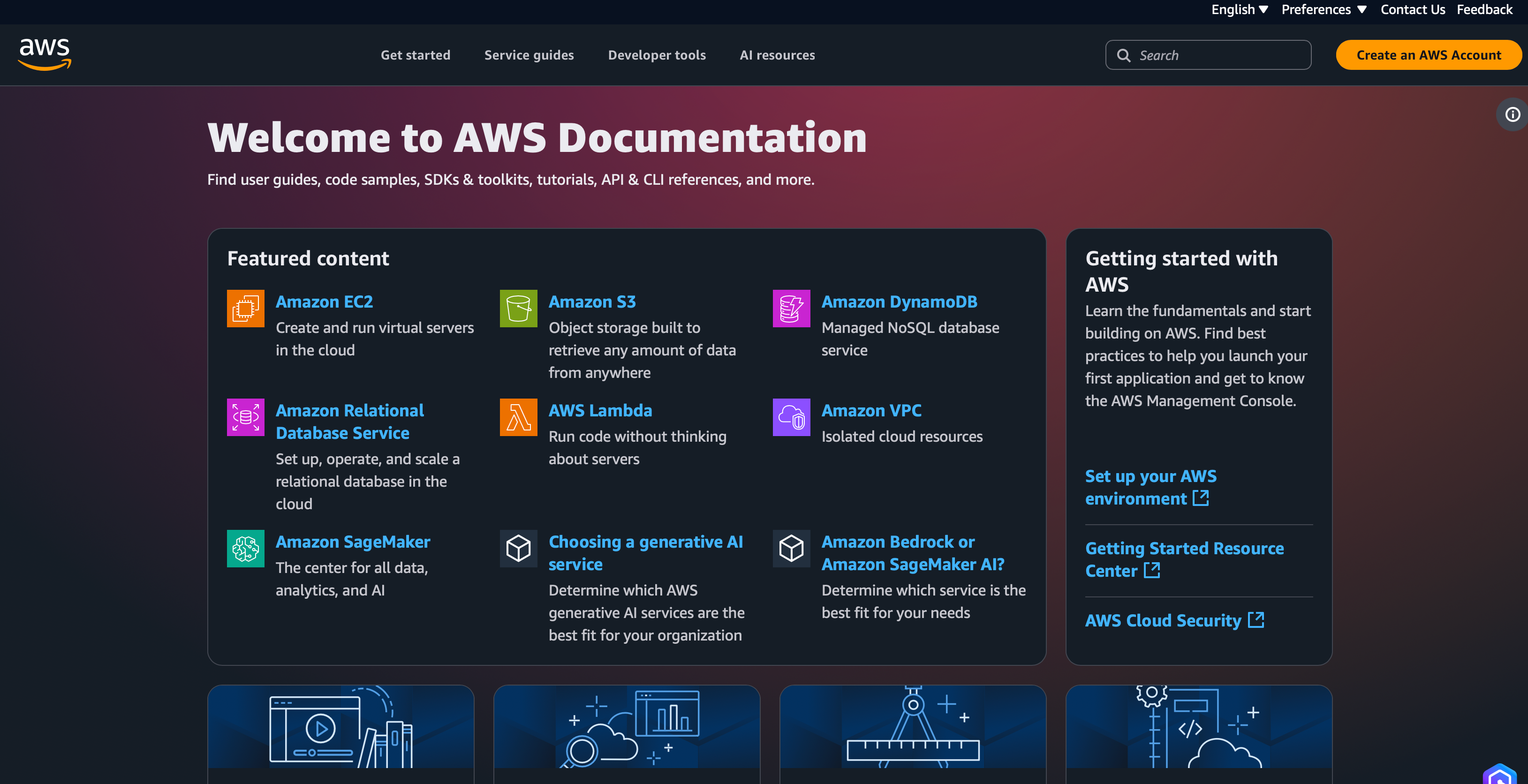
Amazon’s native infrastructure as code solution serves as the foundation for teams creating and managing AWS resources through template-driven automation. CloudFormation eliminates manual processes by automatically provisioning and configuring resources defined in JSON or YAML templates.
AWS CloudFormation Key Features
CloudFormation provides several distinctive automation capabilities:
- Change sets that preview modifications before implementation to prevent unintended consequences
- Automatic rollback to the last working state if deployment errors occur
- Cross-account and cross-region deployment through Stack Sets
- Drift detection to identify configuration changes made outside CloudFormation
- State management handled automatically by the service itself
- Registry extension for third-party resource management
- Import capability for existing AWS resources
AWS CloudFormation Pros and Cons
Pros:
- Deep integration with AWS services and resource types
- No additional charges for core AWS resource management
- Built-in safety controls with rollback triggers
- Modular architecture through CloudFormation modules
- Native dependency management between resources
Cons:
- Limited to AWS ecosystem without multi-cloud support
- JSON syntax can be difficult to read and doesn’t support inline comments
- YAML indentation errors can cause deployment failures
- Requires higher-level implementation like AWS CDK for reusable constructs
AWS CloudFormation Best Use Cases
CloudFormation excels primarily for:
- Complete AWS environment management requiring precise control
- Applications needing consistent deployment across multiple AWS regions
- Organizations seeking to treat infrastructure as version-controlled code
- Teams requiring automatic dependency resolution between resources
- Environments needing detailed tracking of infrastructure changes
5. Azure Resource Manager
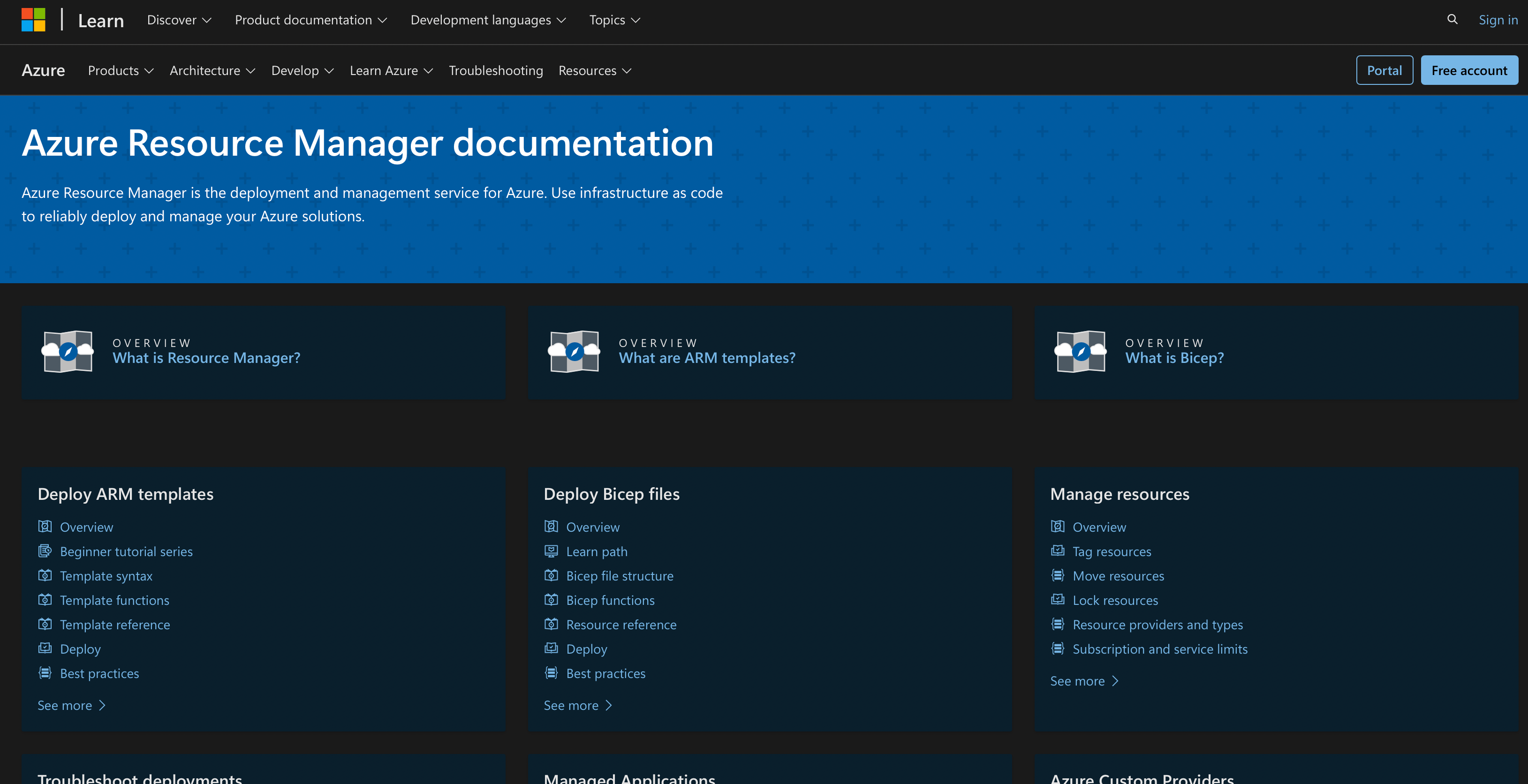
Microsoft’s native infrastructure as code service, Azure Resource Manager (ARM) delivers unified control across Azure environments. This service empowers teams to automate deployments, maintain resource consistency, and strengthen security throughout Azure infrastructures.
Azure Resource Manager Key Features
ARM operates through JSON-based templates that define application resource requirements. The platform provides:
- Resource Grouping: Organizes related resources into logical containers for streamlined management
- Template-Based Deployments: Ensures consistency and repeatability across environments
- Orchestration Engine: Automatically deploys interdependent resources in correct sequence
- Visual Management Tools: Provides GUI-based interfaces for simplified oversight
Azure Resource Manager Pros and Cons
Pros:
- Native integration throughout Azure service ecosystem
- Centralized dashboard controls all resources
- Role-based access control enables precise security management
- Declarative templates guarantee consistent deployments
Cons:
- Azure-exclusive platform prevents multi-cloud strategies
- JSON syntax creates barriers for newcomers
- Template complexity reduces readability at scale
Azure Resource Manager Best Use Cases
ARM serves organizations committed to Microsoft Azure ecosystems. The platform excels for centralized Azure resource management, applications requiring consistent regional deployments, and enterprises demanding integrated security compliance controls.
6. Google Cloud Deployment Manager
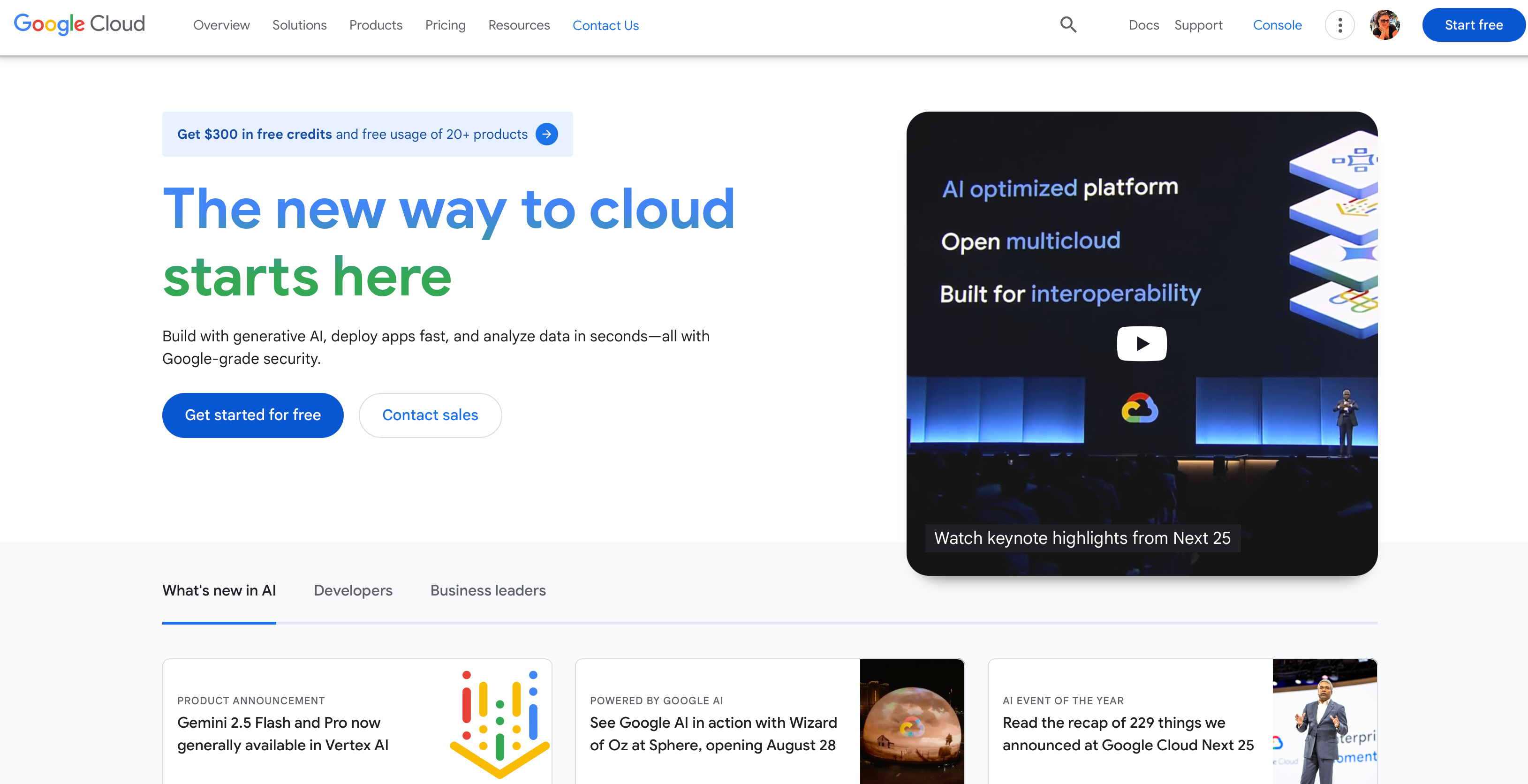
Google Cloud Deployment Manager delivers Google’s native approach to infrastructure automation within the GCP ecosystem. Teams can define resources through configuration files rather than manual console navigation.
Google CDM Key Features
Google Cloud Deployment Manager operates through a declarative model where users specify desired outcomes via YAML configurations. Core capabilities include:
- Template Support: Python and Jinja2 integration enables parameterized deployments
- Preview Mode: Review changes before implementation
- Parallel Deployment: Multiple resources deploy simultaneously
- Dependency Management: Resource references handle interdependencies
- Unlimited read and delete requests with 1,000 write requests daily
Google CDM Pros and Cons
Pros:
- Zero additional costs beyond deployed resources
- Idempotent provisioning ensures consistent results
- Automated rollback during deployment failures
- Declarative approach focuses on outcomes rather than steps
Cons:
- Google Cloud ecosystem only, no multi-cloud capabilities
- Template complexity increases with infrastructure scale
- 1,000 active deployment limit per project
- 1MB configuration file size restrictions
Google CDM Best Use Cases
Google CDM works well for complete GCP infrastructure management, though it lacks CTO2B’s multi-cloud versatility. Ideal scenarios include organizations committed exclusively to Google Cloud, teams requiring automated provisioning workflows, disaster recovery implementations, and security compliance maintenance.
7. Spacelift
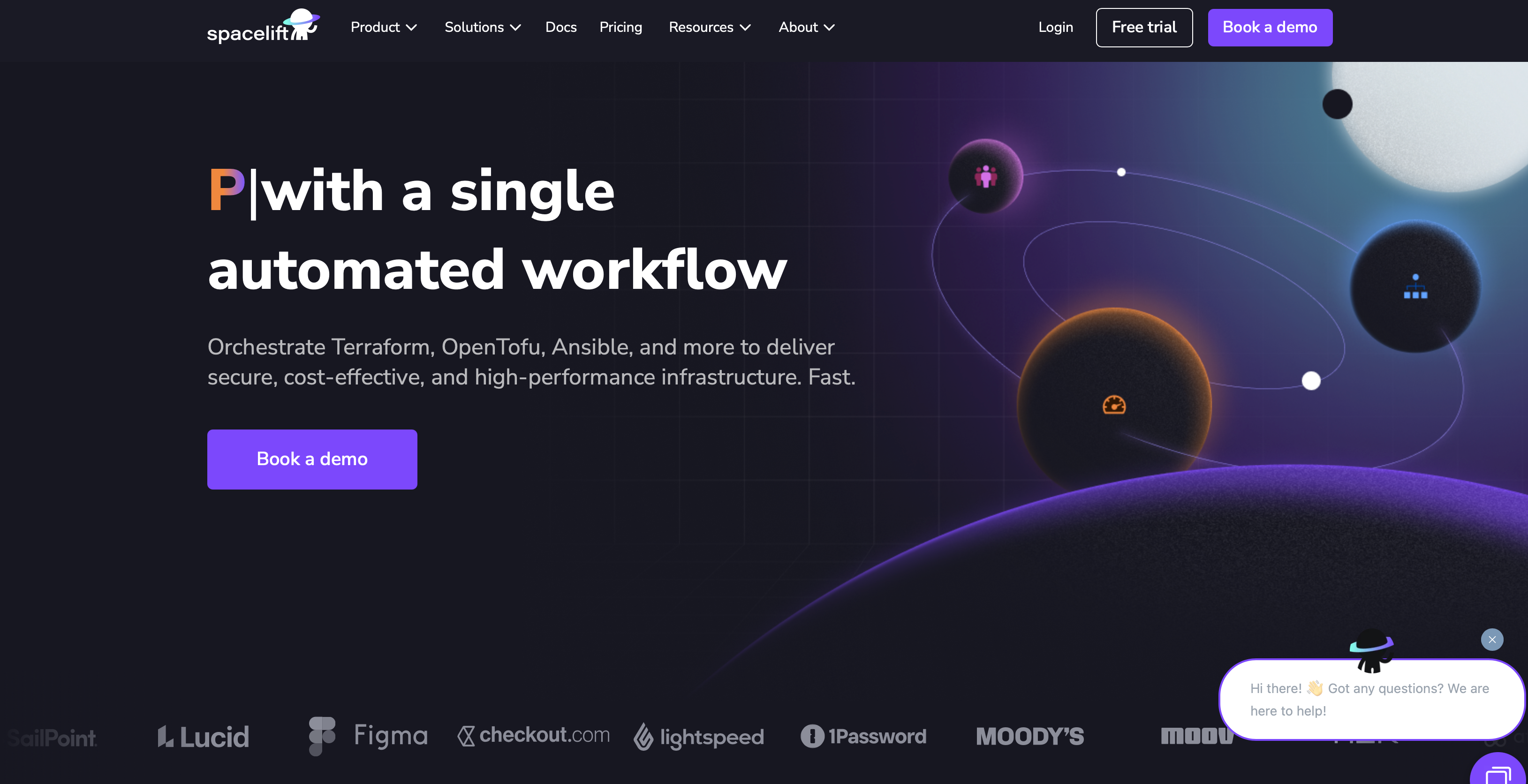
Spacelift operates as an infrastructure orchestration platform that coordinates workflows across multi-tool support environments through unified management. While capable, it lacks the integrated automation approach that makes CTO2B particularly effective for enterprise implementations.
Spacelift Key Features
This platform excels through its comprehensive tool ecosystem supporting Terraform, OpenTofu, Pulumi, CloudFormation, Terragrunt, Ansible, and Kubernetes. Spacelift implements OPA-based policy as code for governance, provides drift detection capabilities for identifying unauthorized infrastructure changes, and enables stack dependencies for sophisticated multi-layer deployment workflows. The platform includes private module registry functionality plus dynamic credential integrations across major cloud providers.
Spacelift Pros and Cons
Pros:
- Coordinates complex multi-tool infrastructure operations
- Resource visualization dashboard enhances infrastructure oversight
- Self-service infrastructure capabilities through blueprint automation
- Concurrency-based pricing model reduces deployment complexity
Cons:
- Free tier excludes deployment notification features
- May exceed requirements for organizations under 500 employees
- Self-hosted deployments offer reduced feature sets compared to SaaS
- Version synchronization challenges between older and newer releases
Spacelift Best Use Cases
Spacelift particularly shines for complex infrastructure management requiring multiple automation tools, organizations implementing security compliance through comprehensive policy frameworks, and teams creating per-PR environments for testing workflows. Best suited for organizations seeking automated infrastructure with detailed audit capabilities.
8. OpenTofu
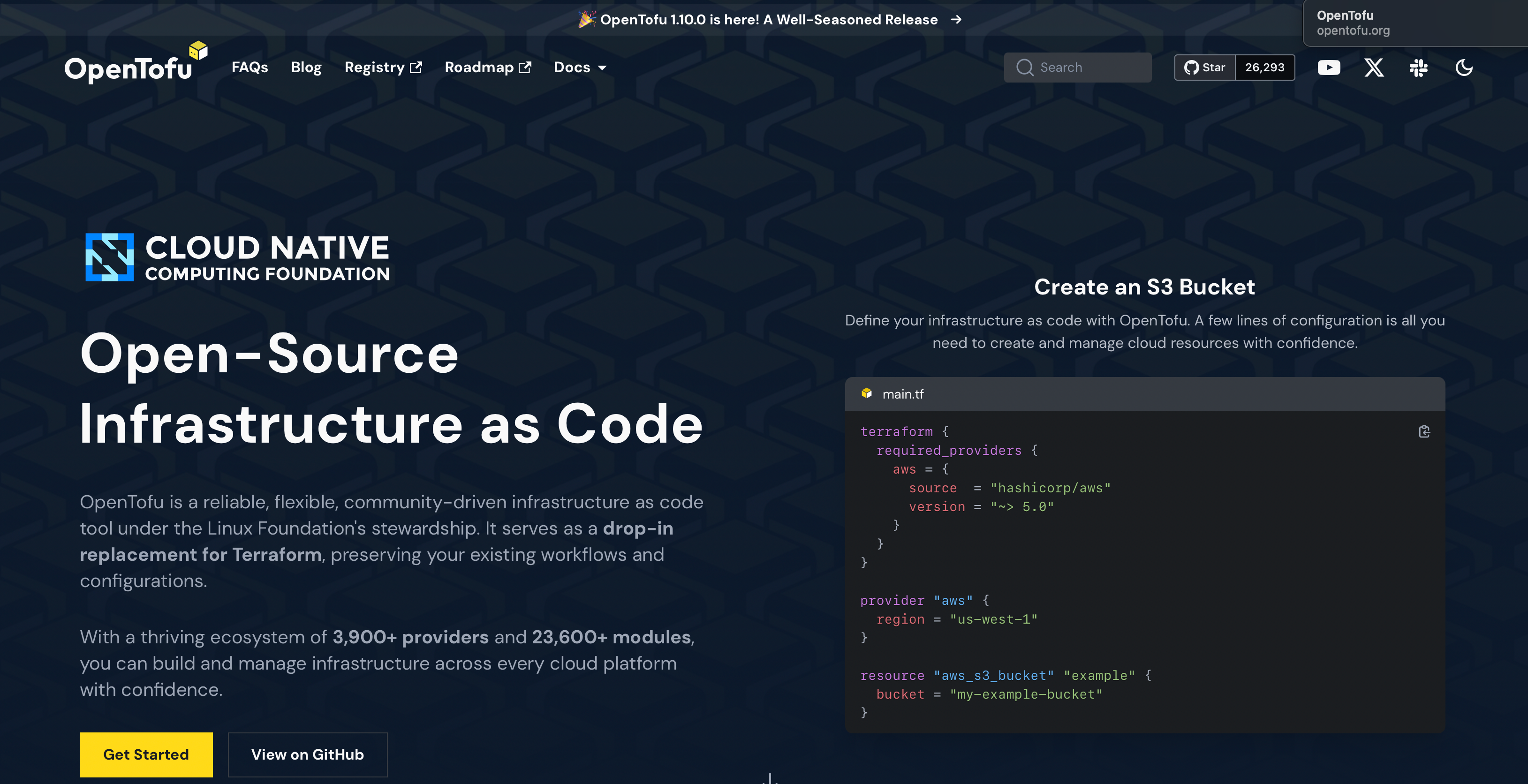
OpenTofu operates as a vendor-independent infrastructure as code solution under the Linux Foundation’s stewardship. This community-driven platform emerged as a Terraform fork following HashiCorp’s license shift from open-source to BUSL.
OpenTofu Key Features
OpenTofu maintains full Terraform compatibility while delivering enhanced capabilities:
- State encryption protecting infrastructure configurations at rest
- Infrastructure as Code architecture with intuitive configuration syntax
- Execution Plans enabling change preview before deployment
- Resource Graph technology optimizing infrastructure build processes
OpenTofu Pros and Cons
Pros:
- Zero licensing costs under Mozilla Public License (MPL 2.0)
- Community-focused development prioritizing user requirements
- Complete Terraform compatibility for seamless migration
- Client-side state encryption with multiple key provider options
Cons:
- No commercial support available
- Newer project with shorter track record
- Development depends on community contributions
OpenTofu Best Use Cases
OpenTofu excels for organizations prioritizing vendor independence and cost control. Perfect for businesses migrating from Terraform, teams requiring complete infrastructure code ownership, and organizations valuing community-driven innovation.
9. Terragrunt
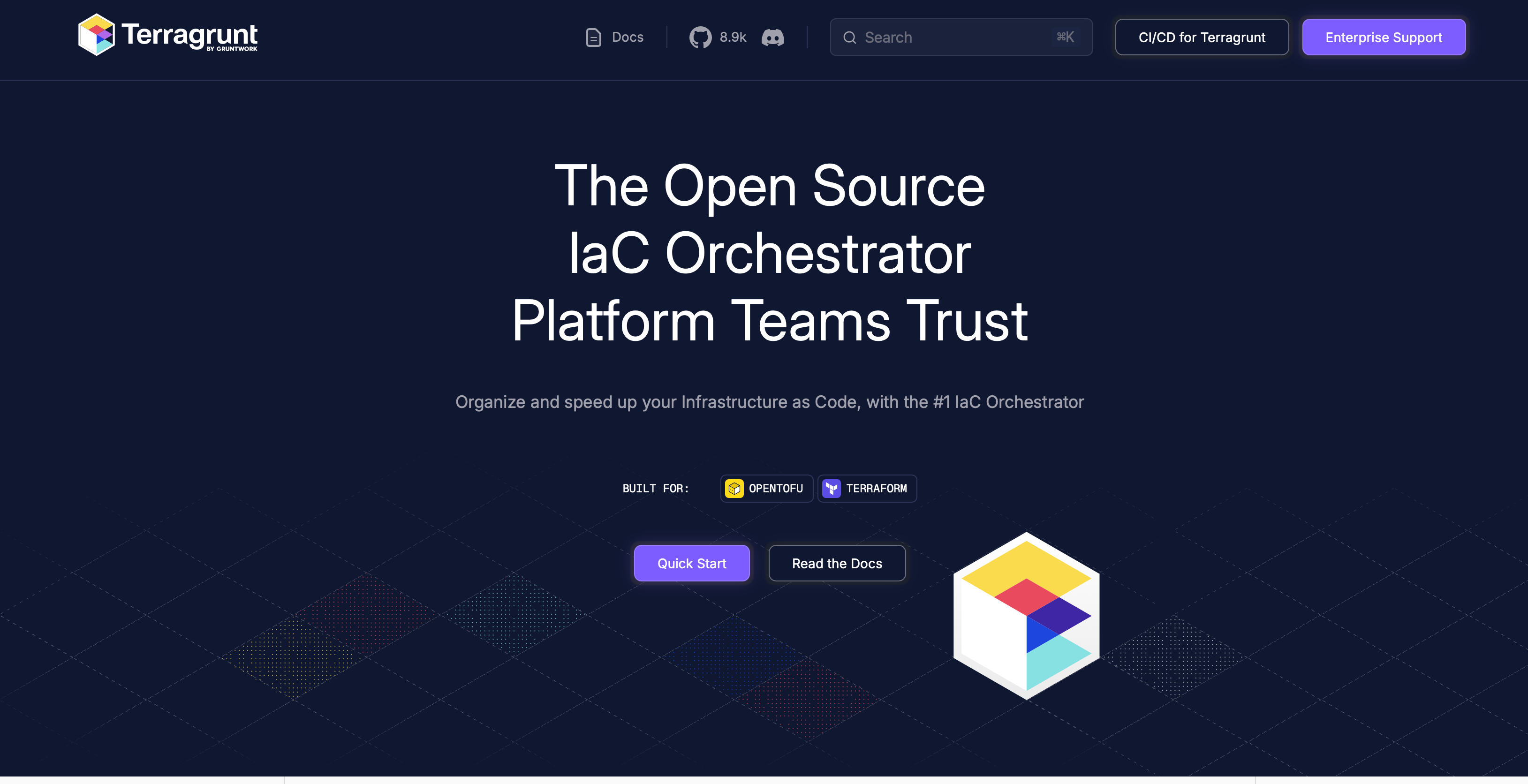
Gruntwork’s Terragrunt functions as a powerful enhancement layer for Terraform that eliminates code duplication while promoting cleaner infrastructure practices. This open-source wrapper specifically tackles the challenges teams face when scaling infrastructure management across multiple environments.
Terragrunt Key Features
Terragrunt eliminates repetitive code by enforcing DRY (Don’t Repeat Yourself) principles throughout your infrastructure codebase. Its core capabilities deliver:
- Configuration Inheritance: Create common parameters once and apply across all environments
- Remote State Management: Streamlines Terraform state file handling across multiple environments
- Multi-region Deployments: Deploy infrastructure across regions with minimal code changes
- Dependency Management: Automates infrastructure component dependencies
- IaC Engines: Customize infrastructure update processes
Terragrunt Pros and Cons
Pros:
- Eliminates code duplication through centralized configurations
- Boosts modularity and code reusability
- Executes Terraform commands across multiple modules simultaneously
- Simplifies multi-account AWS management
Cons:
- Adds complexity requiring additional setup time
- Creates another tool dependency in your stack
- No Terraform Cloud compatibility
- Learning curve for teams new to the wrapper approach
Terragrunt Best Use Cases
Terragrunt shines for multi-environment infrastructure management across development, staging, and production systems. Teams seeking to scale Terraform implementations while maintaining clean, reusable code structures will find this wrapper invaluable.
10. Crossplane
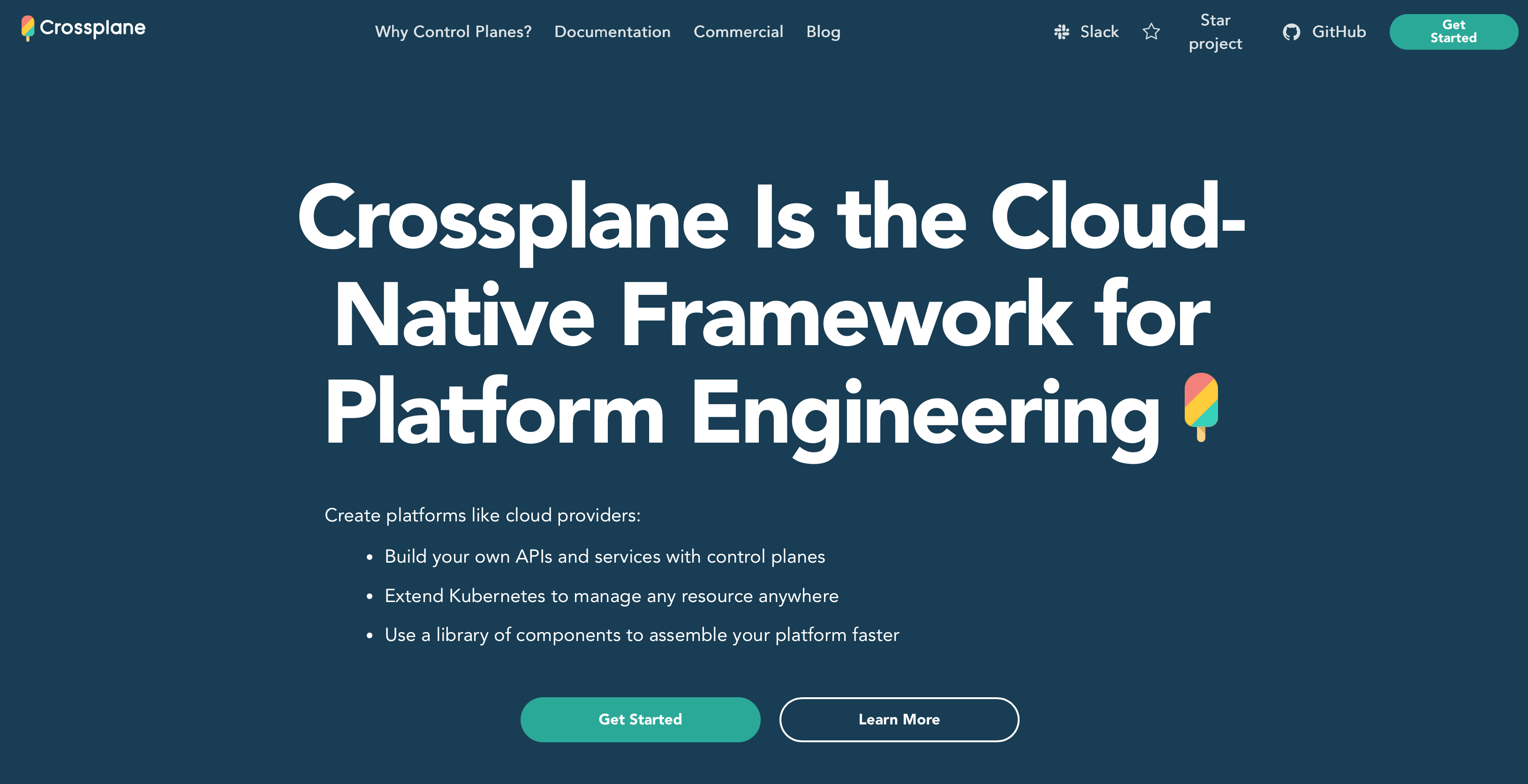
Crossplane extends Kubernetes into a universal control plane for managing resources across different cloud providers. This open-source CNCF project enables infrastructure automation through familiar Kubernetes patterns rather than traditional IaC approaches.
Crossplane Key Features
Continuous reconciliation automatically corrects configuration drift without manual intervention. Crossplane uses Custom Resource Definitions (CRDs) to represent external resources like databases, clusters, and storage buckets. Teams can:
- Define infrastructure through declarative Kubernetes manifests
- Create custom APIs enabling self-service infrastructure access
- Build dynamic configurations using Go and Python
- Eliminate state file management complexities
Crossplane Pros and Cons
Pros:
- Automatic drift correction maintains desired infrastructure state
- Native integration with existing Kubernetes workflows and tooling
- Multi-cloud capabilities across AWS, Azure, and GCP
- No state files to manage or corrupt
Cons:
- Requires existing Kubernetes expertise and infrastructure
- Missing preview functionality for changes before implementation
- API server performance degrades when adding multiple providers
- YAML configurations become complex at enterprise scale
Crossplane Best Use Cases
Kubernetes-committed organizations benefit most from Crossplane’s unified infrastructure management approach. It excels when teams need continuous state reconciliation, want to prevent manual infrastructure changes, and require seamless integration with existing Kubernetes operations.
11. Kubernetes Operators
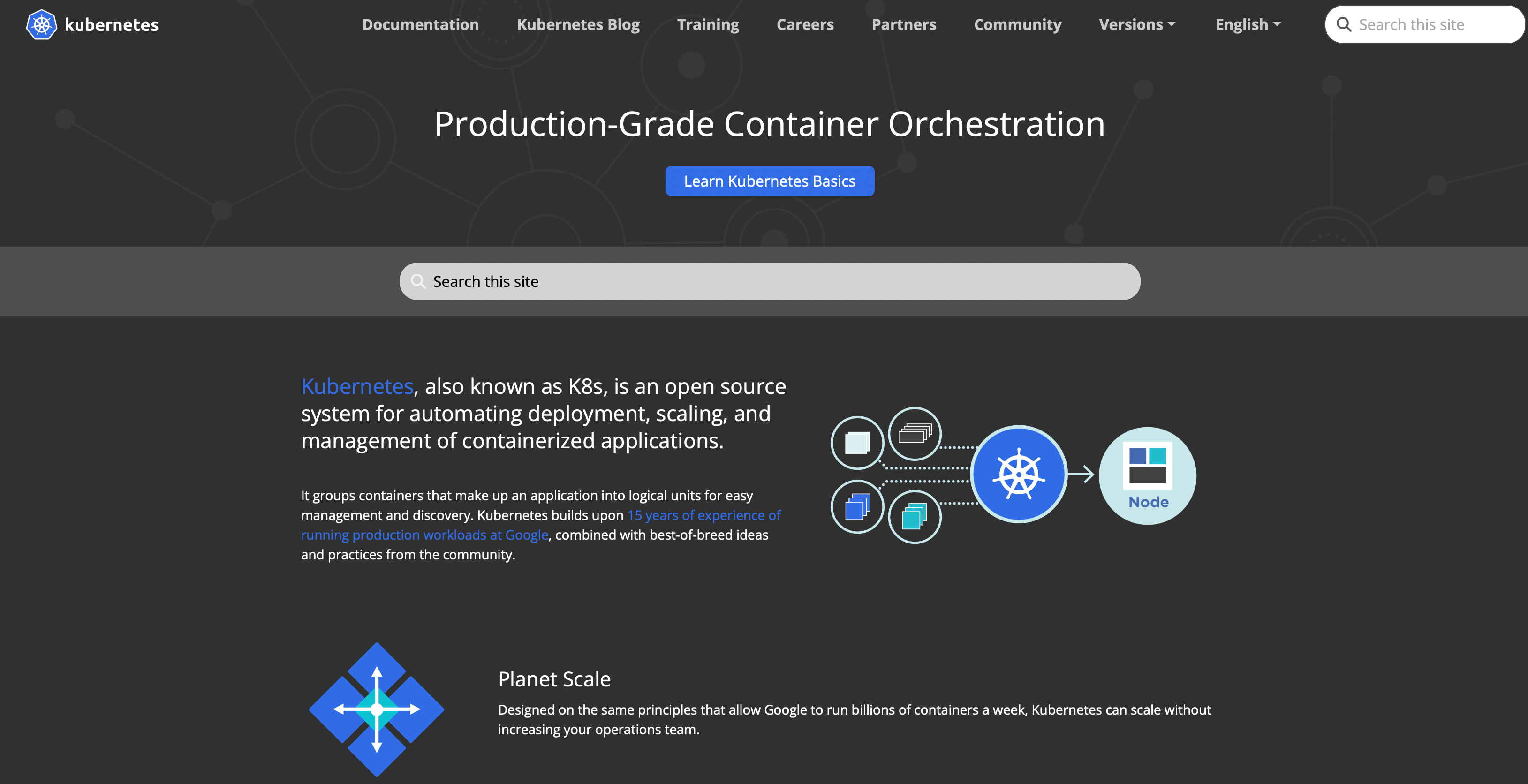
Kubernetes Operators deliver specialized infrastructure automation by extending Kubernetes capabilities through custom resources. These tools continuously monitor applications and automatically reconcile actual states with desired configurations, moving beyond traditional IaC approaches.
Kubernetes Operators Key Features
Operators encode operational knowledge directly into software, following Kubernetes’ control loop principles. They automate complex tasks including deployment orchestration, backup management, application upgrades, and leader elections for distributed systems. Native Kubernetes API integration enables drift detection and continuous reconciliation.
Kubernetes Operators Pros and Cons
Pros:
- Automatic recovery from application failures
- Simplified management of stateful applications
- Centralized configuration storage and control
- Native integration with Kubernetes tooling
Cons:
- Potential loss of user control over deployed resources
- Additional maintenance overhead for operator code
- High privilege requirements creating security risks
- Steep learning curve for implementation
Kubernetes Operators Best Use Cases
Operators excel with complex stateful applications like databases requiring high availability configurations. They work best as specialized automation supplements to broader IaC platforms like CTO2B for specific Kubernetes-native workloads.
12. Red Hat
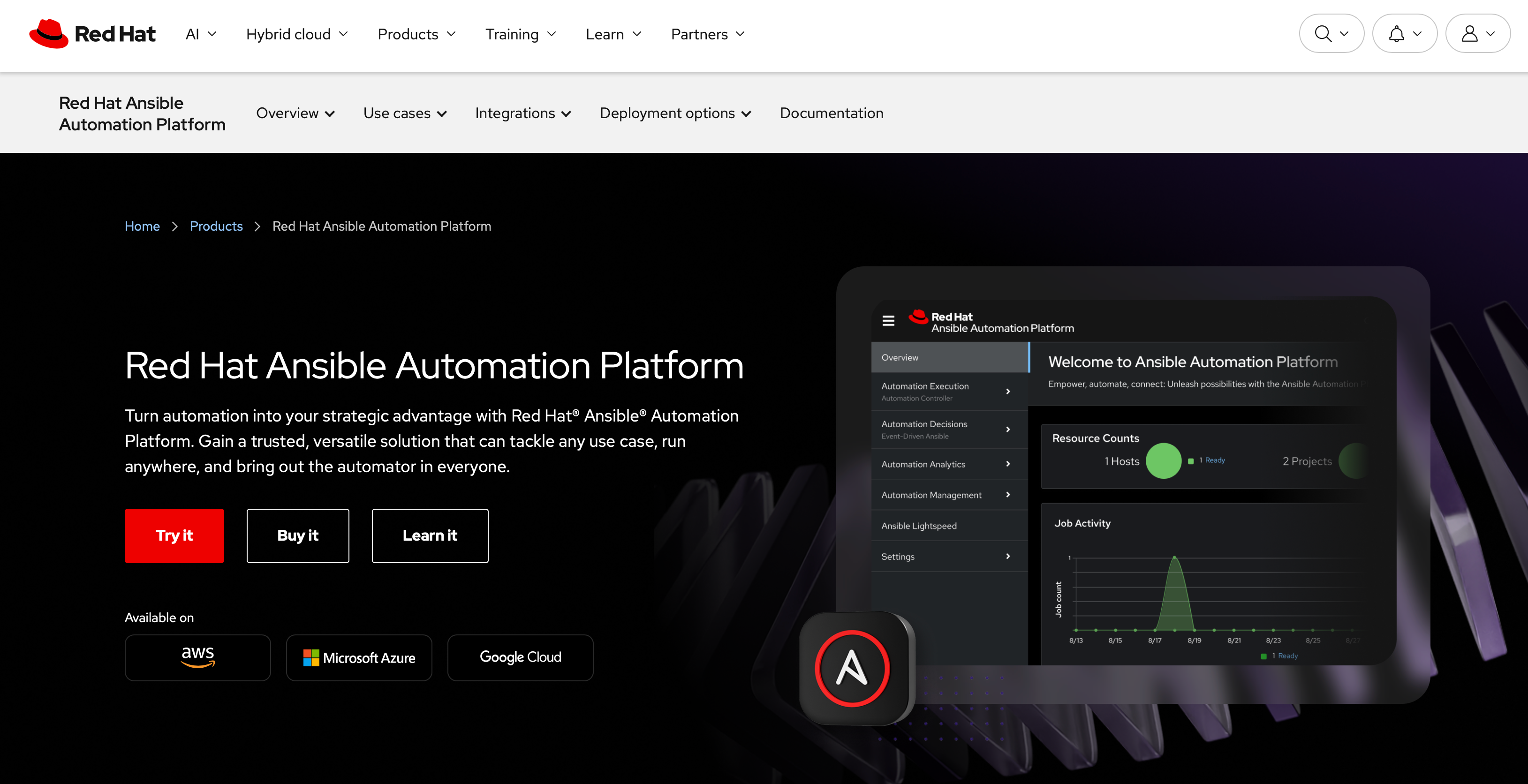
Red Hat’s Ansible delivers streamlined configuration management through its distinctive agentless architecture. This automation platform sets itself apart by eliminating the complexity that plagues traditional infrastructure tools.
Ansible Key Features
Ansible operates over standard SSH connections, requiring no agent software installation on target systems. Teams define desired states through YAML-based playbooks that read like plain English. The platform provides event-driven automation for proactive issue handling, access to over 140 certified content collections from more than 60 industry partners, and automatic drift detection through built-in monitoring capabilities.
Ansible Pros and Cons
Pros:
- Quick learning curve with documentation that gets teams productive fast
- Python foundation makes setup simple since Python libraries exist on most Linux systems
- Agentless design eliminates maintenance overhead and performance issues
- Bridges the gap between IT operations and development teams
Cons:
- GUI provides only 85% of command-line functionality
- Missing state tracking compared to other configuration tools
- Windows support still developing
- Smaller community than Chef or Puppet alternatives
Ansible Best Use Cases
Organizations choose Ansible for infrastructure automation spanning configuration management, application deployment, and network device control. Teams benefit most when requiring consistent system states across environments, automating security compliance through policy enforcement, or simplifying virtual infrastructure management.
13. Chef
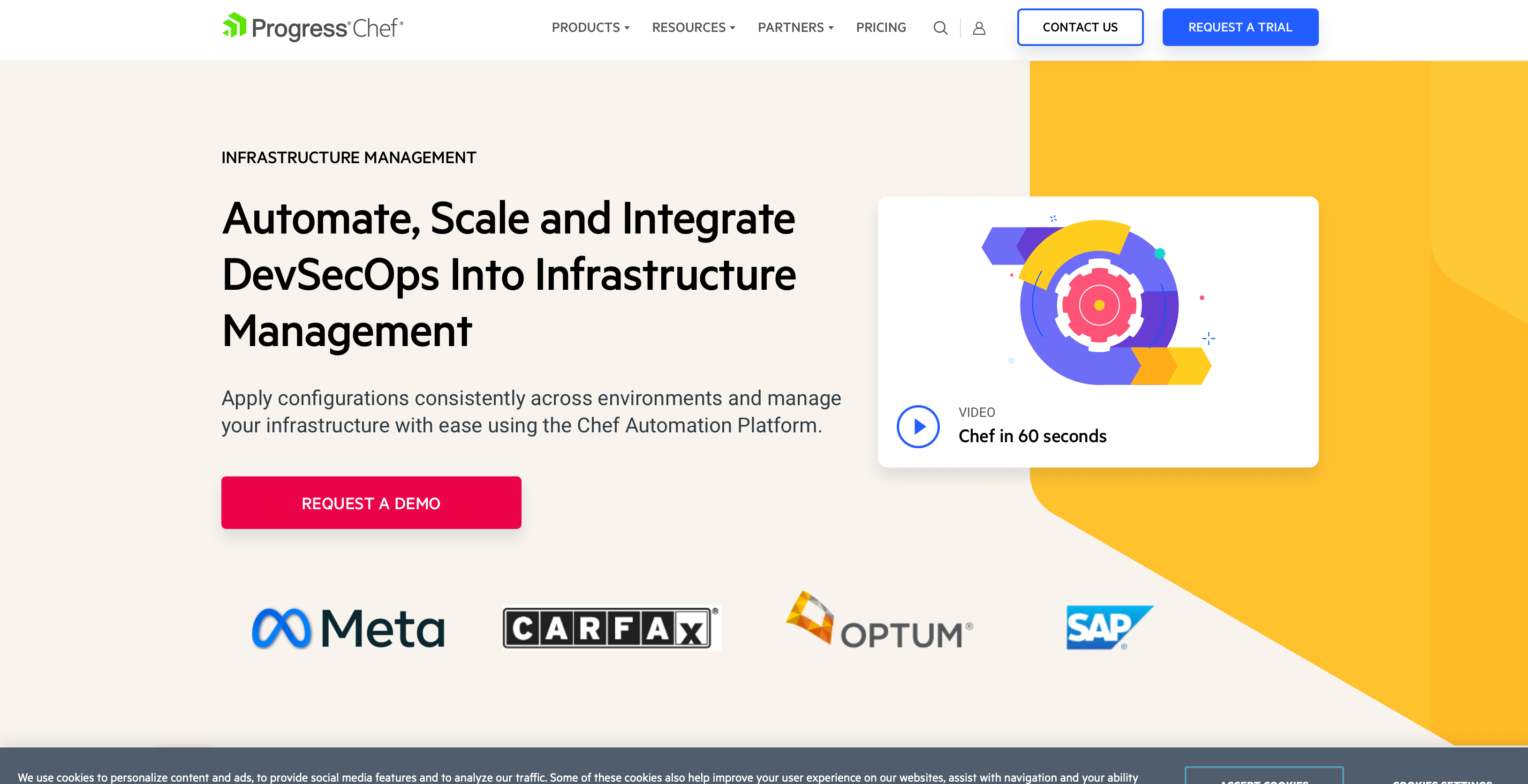
Ruby-powered Chef enables infrastructure automation through its distinctive cookbook methodology. This configuration management platform converts infrastructure requirements into executable code, delivering consistent server configurations across diverse environments through its recipe-based architecture.
Chef Key Features
Chef’s architecture centers on three essential components: Chef Server for centralized configuration storage, Chef Workstation for development workflows, and Chef Client for node configuration execution. The platform’s “cookbooks” contain “recipes” written in Ruby DSL to define precise system configurations. Core capabilities include infrastructure as code implementation, continuous compliance monitoring, node management with advanced filtering, and job orchestration with customizable automation.
Chef Pros and Cons
Pros:
- Enables creativity through flexible infrastructure customization
- Provides instant gratification through visible results of automated deployments
- Offers excellent learning opportunities across various culinary-inspired techniques
- Supports cross-platform compatibility across Windows, Linux, and cloud environments
Cons:
- Requires steep learning curve due to Ruby knowledge requirements
- Presents complexity in overhead management
- Demands significant initial setup investment
- May overwhelm smaller teams with its enterprise-level complexity
Chef Best Use Cases
Chef delivers exceptional value for organizations managing large-scale infrastructures requiring consistent configurations. The platform excels for businesses needing automated compliance monitoring, multi-platform management, and complex deployment orchestration.
14. SaltStack
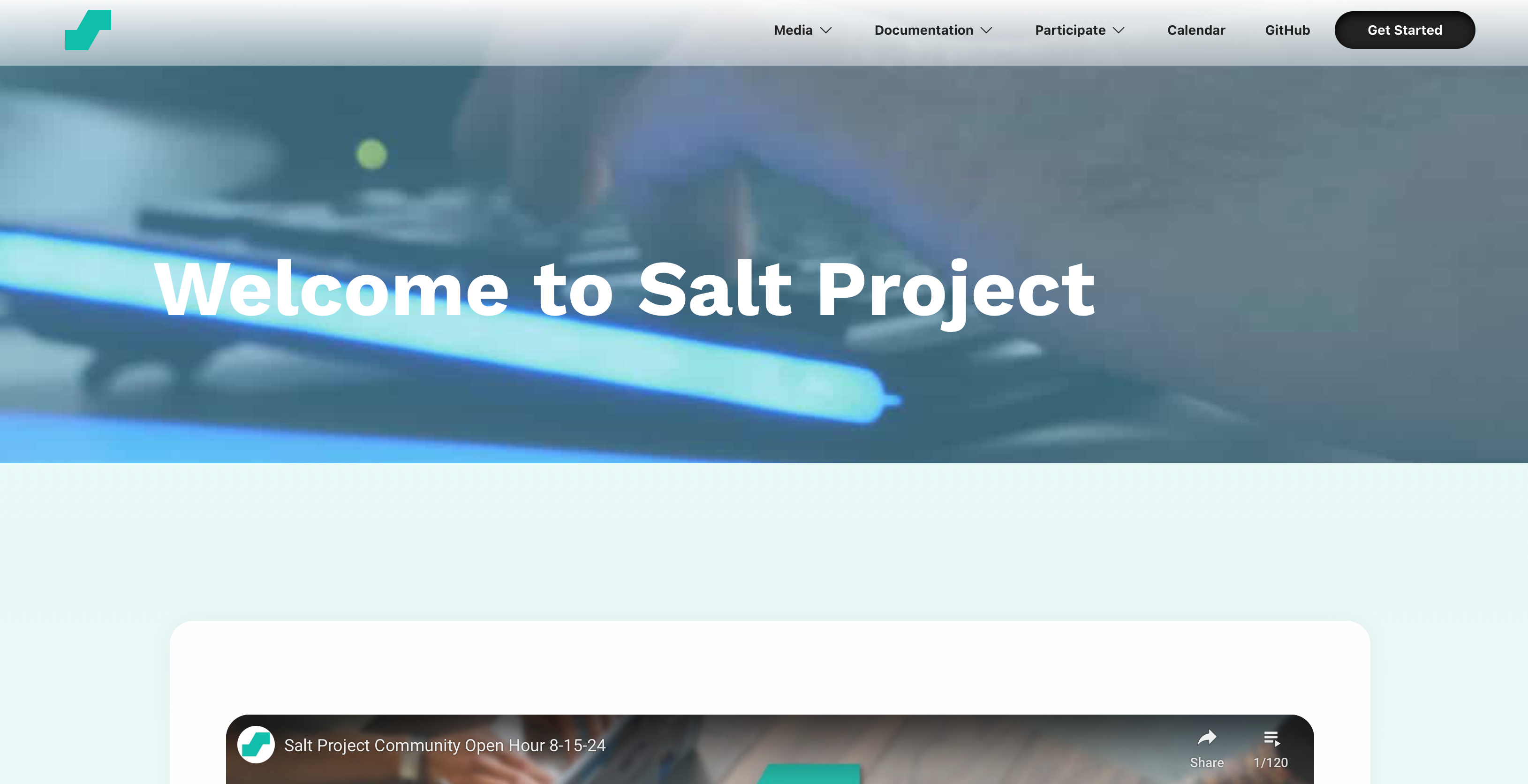
SaltStack delivers high-speed infrastructure automation through its event-driven architecture, distinguishing itself from traditional IaC approaches. Developed by Thomas S Hatch in 2011, this Python-based solution empowers configuration management while enabling rapid remote execution across distributed systems.
SaltStack Key Features
SaltStack operates on a Master-Minion model where the Salt Master controls multiple Minions across distributed environments. Key capabilities include:
- ZeroMQ messaging system enabling near-real-time command execution
- YAML-based “Salt States” that define desired system configurations
- Event-driven Reactor system that automatically responds to infrastructure changes
- “Pillar Data” for secure credential and configuration storage
- Built-in security using AES encryption for communications
SaltStack Pros and Cons
Pros:
- Commands execute near-instantaneously across vast infrastructures
- Highly scalable architecture handling thousands of nodes with minimal latency
- Cross-platform support including Linux, Windows, Mac OS X, and UNIX
- Automatic remediation of issues found during security scans
Cons:
- Steep learning curve for newcomers
- Heavy resource consumption affecting performance
- Limited web UI capabilities
- Complex debugging requiring deep knowledge of Salt internals
SaltStack Best Use Cases
SaltStack proves particularly effective for organizations managing large-scale distributed IT environments. It delivers value for teams requiring automated security compliance, self-healing infrastructure capabilities, and unified control across hybrid deployments.
15. Puppet
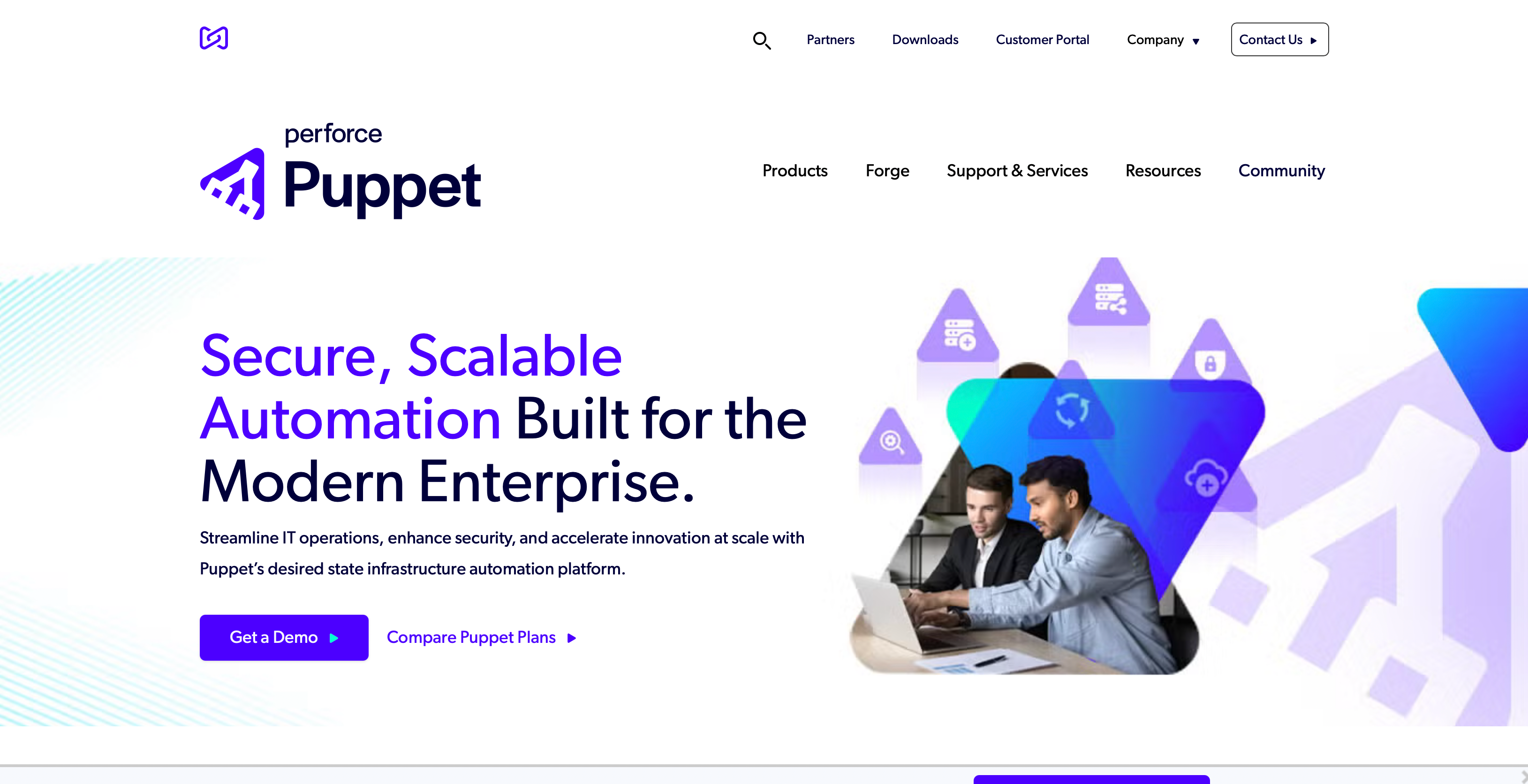
Puppet delivers proven infrastructure automation through its declarative Puppet Code language and master-agent architecture. This established configuration management platform automates server provisioning across diverse environments with battle-tested reliability.
Puppet Key Features
The platform’s powerful abstraction layer enables seamless cross-platform deployment while maintaining consistency. Puppet provides built-in reporting capabilities, idempotent operations that eliminate redundant changes, and access to thousands of pre-built configurations through its module ecosystem. Enterprise versions include robust role-based access control for security management.
Puppet Pros and Cons
Pros:
- Open-source foundation with extendable architecture
- Cross-platform compatibility across Linux, Unix, Windows, and MacOS
- Consistent deployments ensuring configuration stability
- Detailed reporting capabilities for change tracking
Cons:
- Requires significant learning investment compared to simpler alternatives
- Resource-intensive architecture demands substantial overhead
- Master-agent setup creates complexity in large environments
- Pull-based model limits real-time capabilities
Puppet Best Use Cases
Large enterprises with complex infrastructure requirements represent Puppet’s core strength. The platform excels where organizations need automated configuration management, compliance enforcement, and consistent deployment across heterogeneous systems.
16. Vagrant

HashiCorp’s Vagrant enables developers to create consistent, reproducible development environments through virtual machine automation. Released in 2010, this infrastructure as code tool specializes in simplifying local development setup rather than large-scale cloud deployments.
Vagrant Key Features
Vagrant operates through a single configuration file approach that defines entire environments. The platform supports multiple providers including VirtualBox, VMware, AWS, and Docker. Key capabilities include automated networking with port forwarding, simplified VM creation, and cross-platform compatibility across Windows, macOS, and Linux.
Vagrant Pros and Cons
Pros:
- Environment setup time drops from days to hours
- Eliminates “works on my machine” issues through identical configurations
- Enables complete development environment sharing with team members
- Integrates with provisioning tools like Chef and Puppet
Cons:
- Focused primarily on virtual machine management
- Limited cloud infrastructure capabilities
- Resource-intensive when running multiple VMs
Vagrant Best Use Cases
Vagrant serves software development teams requiring consistent environments. It excels for replicating development environments among multiple developers, creating test systems quickly, and enabling designers to work without environment configuration concerns.
17. AWS CDK
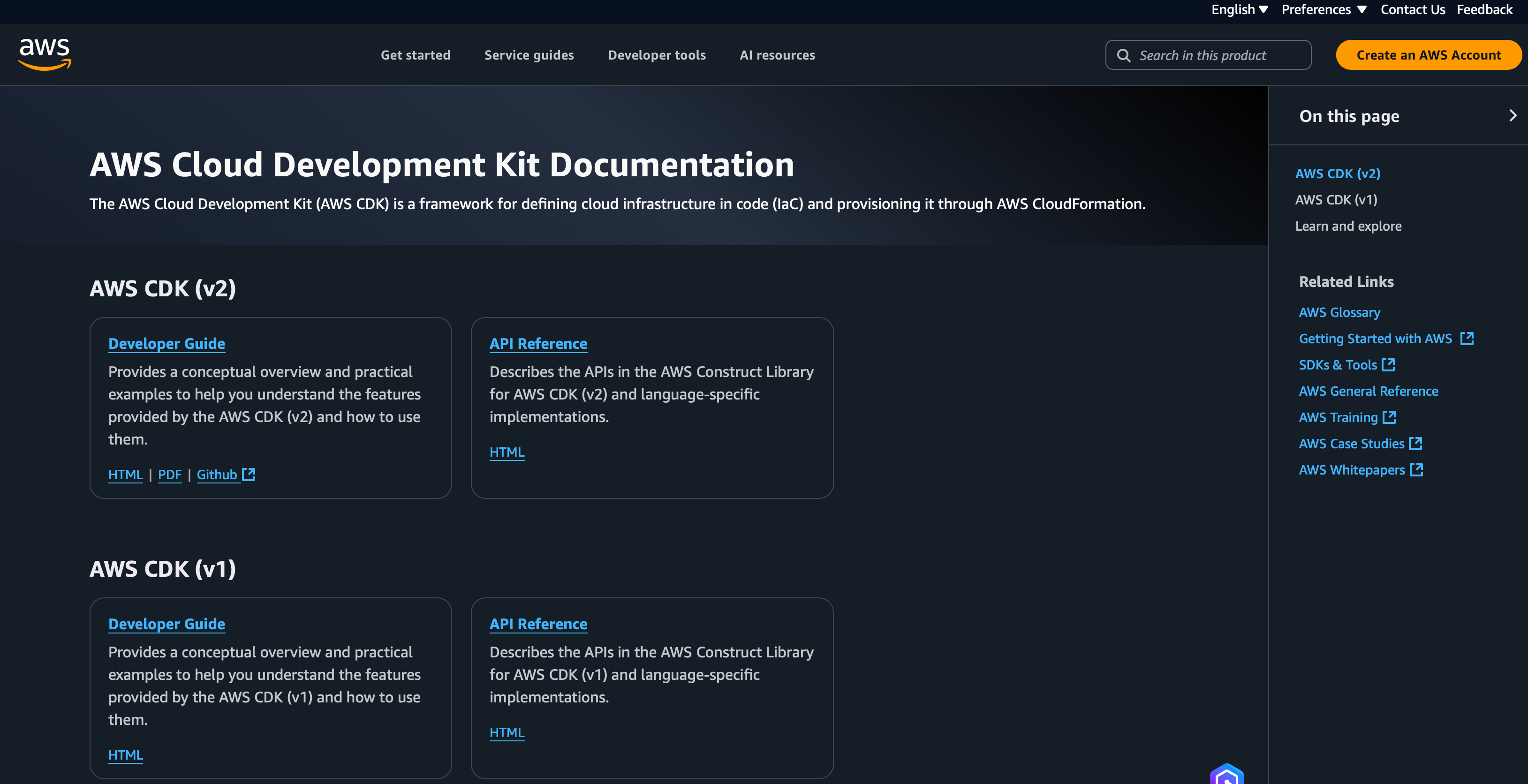
The AWS Cloud Development Kit (AWS CDK) operates as an open-source framework enabling infrastructure definition through familiar programming languages, then deploying via AWS CloudFormation. AWS CDK eliminates the need for domain-specific languages by allowing developers to apply existing programming expertise directly to infrastructure management.
AWS CDK Key Features
AWS CDK supports infrastructure definition using TypeScript, JavaScript, Python, Java, C#, and Go (in Developer Preview). The framework operates through constructs, reusable cloud components across three levels: L1 for direct CloudFormation resources, L2 providing higher-level abstractions with sensible defaults, and L3 delivering complete architectural patterns. CloudFormation templates generate automatically during synthesis.
AWS CDK Pros and Cons
Pros:
- Programming languages developers already know reduce adoption barriers
- Construct libraries enable powerful code reusability
- Existing development workflows integrate seamlessly
- Asset bundling capabilities handle complex deployments
Cons:
- Bootstrapped environments required in each AWS account
- AWS ecosystem limitation prevents multi-cloud strategies
- State file management introduces familiar complexities
- CloudFormation deployment speeds create dependencies
AWS CDK Best Use Cases
AWS CDK serves organizations combining infrastructure and runtime code within unified repositories. It excels for applications requiring automated deployments triggered by code changes, teams preferring continuous deployment without manual intervention, and enterprises needing centralized construct libraries aligned with organizational standards.
Tool Comparison Overview
| Tool | Key Features | Main Pros | Main Cons | Best Use Cases |
| 1. CTO2B | – Multi-cluster management across clouds – GitOps integration – Real-time monitoring – Automated scaling – Disaster recovery | – 40% cloud cost savings – 30% reduced development time – 60% increased security – Unified platform – User-friendly interface | – Enterprise focus may exceed small team needs – Initial setup period required | – SaaS businesses – E-commerce platforms – Financial institutions – Multi-cloud implementations |
| 2. Terraform | – Multi-cloud support – HCL language – State tracking – Dependency management | – Consistent deployment – Reusable modules – Large community – Idempotent operations | – Steep learning curve – State file complexity – Third-party dependency | – Multi-cloud infrastructures – Multi-tier applications – Global deployments |
| 3. Pulumi | – Multi-language support – API coverage – Testing frameworks – Dynamic providers | – Standard programming languages – Powerful abstractions – Automated secret management | – Challenging for non-coders – Complex project structure – More documentation needed | – Complex infrastructure – Modern cloud architectures – Multi-cloud environments |
| 4. AWS CloudFormation | – Change sets – Automatic rollback – Drift detection – Stack Sets | – Deep AWS integration – No additional charges – Built-in safety controls | – AWS-only – Complex JSON syntax – YAML indentation issues | – AWS-specific deployments – Multi-region applications – Version-controlled infrastructure |
| 5. Azure Resource Manager | – Resource grouping – Template deployments – Visual tools – Orchestration | – Deep Azure integration – Centralized management – Role-based access | – Azure-only – Steep JSON learning curve – Template complexity | – Azure-focused organizations – Regional deployments – Security compliance |
This comparison highlights the top 5 tools from our complete 17-tool evaluation. CTO2b leads with exceptional automation capabilities, measurable cost savings, and superior security enhancements that deliver tangible business results.
Conclusion
The right Infrastructure as Code tool makes the difference between streamlined operations and costly inefficiencies. Our evaluation of 17 IaC solutions reveals one clear winner: CTO2B delivers what others can’t.
CTO2B earns the top position through its unique combination of automation power and business results. No other platform matches its ability to reduce cloud expenses by 40% while accelerating development cycles by 30%. The unified approach eliminates tool sprawl – you get everything needed for modern infrastructure management in one solution.
Security concerns drive many infrastructure decisions today. The Capital One breach we discussed earlier demonstrates exactly why manual configuration fails modern businesses. CTO2B addresses this reality by boosting infrastructure security up to 60% above traditional approaches. Teams without DevOps specialists can still deploy production-ready environments in minutes.
Multi-cloud tools like Terraform and Pulumi certainly have merit for specific technical requirements. Cloud-native solutions including AWS CloudFormation and Azure Resource Manager excel within their ecosystems. None offer CTO2B’s enterprise-ready integration across platforms, security layers, and business processes.
Manual infrastructure management belongs in the past. Organizations that embrace Infrastructure as Code gain competitive advantages through faster deployments, lower costs, and enhanced security. CTO2B stands as the premier choice for 2025, delivering automation capabilities that produce measurable business results.
Ready to experience what automated infrastructure can do for your business? CTO2B provides the comprehensive solution modern teams need to succeed. Let’s talk.
FAQs
What are the main benefits of using Infrastructure as Code (IaC) tools?
IaC tools automate infrastructure provisioning, reduce human error, enhance efficiency, and improve scalability. They enable consistent deployments, better documentation, enhanced collaboration, and help ensure compliance with industry regulations.
How does CTO2B compare to other IaC tools like Terraform or AWS CloudFormation?
CTO2B offers a more comprehensive solution with multi-cloud support, integrated CI/CD tools, and advanced security features. It provides up to 40% cost savings on cloud infrastructure and increases security by 60%, outperforming specialized tools in terms of overall efficiency and ease of use.
Are there any free Infrastructure as Code tools available?
Yes, several IaC tools offer free versions. Terraform has an open-source CLI, AWS CloudFormation is free for AWS resources, and OpenTofu is a fully open-source alternative. However, enterprise features and support often come with paid tiers.
How difficult is it to learn and implement Infrastructure as Code?
The learning curve varies depending on the tool. Some, like Ansible, are relatively easy to learn, while others like Terraform or Chef may require more time to master. Tools that use familiar programming languages, such as Pulumi or AWS CDK, can be easier for developers to adopt.
Can Infrastructure as Code tools work across multiple cloud providers?
Yes, many IaC tools support multi-cloud deployments. CTO2B, Terraform, and Pulumi are particularly strong in this area, allowing users to manage resources across AWS, Azure, Google Cloud, and other providers using a single tool and consistent workflow.
References
[1] – https://spacelift.io/blog/infrastructure-as-code-tools
[2] – https://www.sentinelone.com/cybersecurity-101/cloud-security/iac-tools/
[3] – https://bluelight.co/blog/best-infrastructure-as-code-tools
[4] – https://cto2b.io/
[5] – https://cto2b.io/solutions/devops-automation/
[6] – https://cto2b.io/solutions/
[7] – https://cto2b.io/blog/cloud-automation-tools/
[8] – https://cto2b.io/solutions/cloud-infrastructure-management/
[9] – https://cto2b.io/success-stories/inventi-payment-infrastructure-overhaul/
[10] – https://www.altexsoft.com/blog/terraform-pros-and-cons/
[11] – https://developer.hashicorp.com/terraform/tutorials/aws-get-started/infrastructure-as-code
[12] – https://www.pluralsight.com/resources/blog/cloud/what-is-terraform-infrastructure-as-code-iac
[13] – https://www.hashicorp.com/en/pricing
[14] – https://developer.hashicorp.com/terraform/intro/use-cases
[15] – https://developer.hashicorp.com/terraform/language/stacks/use-cases
[16] – https://www.pulumi.com/docs/iac/concepts/vs/terraform/
[17] – https://encore.cloud/resources/pulumi
[18] – https://www.pulumi.com/product/infrastructure-as-code/
[19] – https://www.firefly.ai/academy/pulumi-vs-terraform-vs-cloudformation-which-iac-tool-is-best-for-your-infrastructure
[20] – https://devtron.ai/blog/introduction-to-pulumi-a-modern-infrastructure-as-code-platform/
[21] – https://www.pulumi.com/blog/going-beyond-with-advanced-infrastructure-as-code-use-cases/
[22] – https://www.pulumi.com/pricing/
[23] – https://aws.amazon.com/cloudformation/pricing/
[24] – https://encore.cloud/resources/azure-resource-manager
[25] – https://www.xenonstack.com/blog/azure-resource-manager-iac
[26] – https://www.netapp.com/blog/azure-cvo-blg-azure-resource-manager-arm-benefits-and-best-practices/
[27] – https://cloud.google.com/deployment-manager/docs/fundamentals
[28] – https://console.cloud.google.com/marketplace/product/google-cloud-platform/cloud-deployment-manager
[29] – https://cloud.google.com/deployment-manager/quotas
[30] – https://dev.to/spacelift/what-is-spacelift-key-features-benefits-use-cases-3o4k
[31] – https://spacelift.io/blog/devops-best-practices
[32] – https://spacelift.io/blog/how-specialized-solution-can-improve-your-iac
[33] – https://zeet.co/blog/spacelift-vs-terraform-cloud
[34] – https://www.peerspot.com/products/spacelift-pros-and-cons
[35] – https://spacelift.io/pricing
[36] – https://www.reddit.com/r/devops/comments/pjqi4f/advanced_spacelift_use_cases/
[37] – https://spacelift.io/blog/why-devops-engineers-recommend-spacelift
[38] – https://opentofu.org/
[39] – https://www.harness.io/blog/why-you-should-use-opentofu-instead-of-terraform
[40] – https://github.com/opentofu/opentofu
[41] – https://atix.de/en/blog/terraform-vs-opentofu-which-solution-is-suitable-for-your-company/
[42] – https://spacelift.io/blog/opentofu-vs-terraform
[43] – https://www.env0.com/blog/opentofu-the-open-source-terraform-alternative
[44] – https://www.infracost.io/glossary/terragrunt/
[45] – https://terragrunt.gruntwork.io/docs/getting-started/overview/
[46] – https://terragrunt.gruntwork.io/docs/features/engine/
[47] – https://www.opstergo.com/blog/understanding-terragrunt-use-cases-and-examples
[48] – https://www.env0.com/blog/terragrunt
[49] – https://www.gruntwork.io/pricing
[50] – https://komodor.com/learn/what-is-crossplane-pros-cons-and-a-quick-tutorial/
[51] – https://www.groundcover.com/blog/crossplane-kubernetes
[52] – https://blog.upbound.io/crossplane-differentiators
[53] – https://medium.com/@vchauhan76/cross-plane-vs-terraform-c8068ae5a6aa
[54] – https://www.cecg.io/blog/crossplane-the-good-the-bad-the-ugly/
[55] – https://dev.to/mechcloud_academy/iac-tool-pricing-comparison-terraform-crossplane-and-pulumi-3oe5
[56] – https://spacelift.io/blog/crossplane-vs-terraform
[57] – https://kubernetes.io/docs/concepts/extend-kubernetes/operator/
[58] – https://www.thestack.technology/how-kubernetes-operators-fit-into-to-platform-building-and-when-traditional-iac-isnt-enough/
[59] – https://blog.px.dev/k8s-operator/
[60] – https://thenewstack.io/kubernetes-when-to-use-and-when-to-avoid-the-operator-pattern/
[61] – https://cloudnativenow.com/features/a-deep-dive-into-kubernetes-operators/
[62] – https://www.digitalocean.com/community/conceptual-articles/an-introduction-to-configuration-management-with-ansible
[63] – https://www.redhat.com/en/technologies/management/ansible/configuration-management
[64] – https://www.upguard.com/blog/top-5-best-and-worst-attributes-of-ansible
[65] – https://www.trustradius.com/products/red-hat-ansible-automation-platform/pricing
[66] – https://www.g2.com/products/red-hat-ansible-automation-platform/pricing
[67] – https://spacelift.io/blog/ansible-use-cases
[68] – https://www.redhat.com/en/technologies/management/ansible/use-cases
[69] – https://snibbs.co/blogs/restaurant-best-practices/pros-and-cons-of-being-a-chef
[70] – https://techcommunity.microsoft.com/blog/itopstalkblog/infrastructure-as-code-iac-comparing-the-tools/3205045
[71] – https://nerdisa.com/chef-io/
[72] – https://www.chef.io/how-to-buy
[73] – https://www.meegle.com/en_us/topics/infrastructure-as-code/chef-for-infrastructure-as-code-automation
[74] – https://www.geeksforgeeks.org/devops/difference-between-saltstack-and-ansible/
[75] – https://curatepartners.com/blogs/skills-tools-platforms/mastering-it-automation-with-saltstack-scalability-speed-and-specialized-talent/
[76] – https://thenewstack.io/ansible-vs-salt-which-is-best-for-configuration-management/
[77] – https://www.wallarm.com/cloud-native-products-101/saltstack-vs-chef-configuration-automation
[78] – https://nerdisa.com/saltstack/
[79] – https://dev.to/shivam_agnihotri/saltstack-a-powerful-configuration-management-and-orchestration-tool-day-35-of-50-days-devops-tools-series-2070
[80] – https://www.tutorialspoint.com/saltstack/saltstack_competitors.htm
[81] – https://www.statsig.com/perspectives/saltstack-pricing-alternatives-cost
[82] – https://www.linkedin.com/pulse/puppet-iac-beginners-introduction-artem-antonenko-t4gyc
[83] – https://ezeelive.com/puppet-pros-cons/
[84] – https://www.upguard.com/blog/open-source-puppet-vs-puppet-enterprise-which-is-right-for-you
[85] – https://www.cortex.io/post/best-infrastructure-as-code-iac-tools
[86] – https://developer.hashicorp.com/vagrant/intro
[87] – https://edgedelta.com/company/blog/most-popular-iac-tools
[88] – https://spotsaas.com/product/vagrant
[89] – https://talent500.com/blog/how-vagrant-can-help-you-ace-at-virtual-machine-management/
[90] – https://www.techtarget.com/searchnetworking/tip/Ansible-vs-Terraform-vs-Vagrant-Whats-the-difference
[91] – https://aws.amazon.com/blogs/devops/best-practices-for-developing-cloud-applications-with-aws-cdk/
[92] – https://aws.amazon.com/cdk/faqs/
[93] – https://tutorialsdojo.com/aws-cloud-development-kit-cdk/
[94] – https://docs.aws.amazon.com/prescriptive-guidance/latest/choose-iac-tool/aws-cdk.html
[95] – https://aws.amazon.com/blogs/devops/best-practices-for-scaling-aws-cdk-adoption-within-your-organization/
